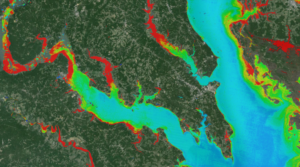The National Aeronautics and Space Administration (NASA) and the Department of the Interior’s U.S. Geological Survey (USGS) share responsibility for the Landsat Data Continuity Mission (LDCM). NASA will develop the flight systems including the spacecraft, instrument, mission operations element and mission launch, and perform on-orbit checkout. The USGS will develop, implement, and operate the ground data acquisition network and image processing and archive facilities and will disseminate products to the user community. In addition, the USGS will be responsible for satellite flight operations. The USGS LDCM acquisition strategy is based upon competitive procurements for the engineering, development, integration and test, and operation of the ground system elements. The two largest USGS LDCM related contracts were awarded in March 2008—the LDCM Data Continuity Contract (LDCC) was awarded to Science Applications International Corporation (SAIC) and the USGS Earth Resources Observation and Science (EROS) Technical Support Services Contract (TSSC) was awarded to Stinger Ghaffarian Technologies, Inc. (SGT). The following list outlines the acquisition strategy for the LDCM ground system segments and their associated elements:
Flight Operations Segment:
The Ground Network Element (GNE) will be procured through a competitive solicitation for ground network equipment and services to ensure repetitive and timely global data acquisition. The exact GNE procurement approach is under study and will be finalized by mid-2008. Definition and integration of the GNE will be supported by the LDCC Contractor.
The Collection Activity Planning Element will be modeled after the successful Long-Term Acquisition Plan employed for Landsat 7 to collect global data and will be developed by the LDCC Contractor.
The Mission Operations Element (systems required for control and management of the spacecraft and instrument) will be competitively procured through NASA’s acquisition process. The Mission Operations Center — a facility to house these operational systems and associated staff — will be configured within the USGS EROS Center facility through competitive procurement of design and facility modification contracts.
The Flight Operations Team will be procured competitively through a USGS solicitation.
Data Processing and Archive Segment:
The Storage and Archive Element and the User Portal Element will be developed by the USGS EROS Center TSSC contractor.
The Image Processing Element and the Ground System Infrastructure Element will be developed by the LDCC Contractor.
Ground System Architecture Analysis and Integration:
The USGS will lead ground system integration activities and will acquire architecture analysis and integration support through a Federally-Funded Research and Development Center (FFRDC) contract. The EROS Center TSSC Contractor will also provide ground system and segment level engineering and integration support.
Further details regarding the USGS LDCM acquisition strategy can be found at http://ldcm.usgs.gov/.

Be Part of What’s Next: Emerging Applications of Landsat at AGU24
Anyone making innovative use of Landsat data to meet societal needs today and during coming decades is encouraged to submit and abstract for the upcoming “Emerging Science Applications of Landsat” session at AGU24.





